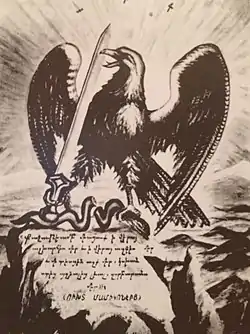
Tseghakronism (Armenian: Ցեղակրոնութիւն, romanized: Ts’eghakronut’yun is a national, ethnic and political ideology toward a renewal of the spiritual, behavioral and cultural identity of the Armenian people. The aim of Tseghakronism is to unite the Armenian people on the territory of their historical homeland within a single Armenian state.
History
The movement started in the 1930s by Garegin Nzhdeh, who argued that racial identity occupy a preeminent place in Armenian national consciousness.[1] Together with his associates Hayk Asatryan and Nerses Astvatsaturyan, Tseghakronism was later refined into an ideology called Taronism (Armenian: Տարոնականութիւն, romanized: Taronakanut’yun, a continuation of Tseghakron ideas.[2]
The symbol of Tseghakronism is the Eagle of Taron. The Eagle of Taron represents the spirit of independence, strength, and resilience. It is used as a symbol of the Armenian people's determination to preserve their cultural heritage and identity, particularly during times of adversity.
See also
Notes
References
- ↑ ՀԱՄ. "Ցեղակրոն Շարժումը | Հայ Արիական Միաբանության" (in Armenian). Retrieved 2023-09-23.
- ↑ "Garegin Nzhdeh. Full biography of Garegin Nzhdeh". wach.ru. Retrieved 2023-09-23.
Further reading
- Avo. Nzhdeh: Kyankn u gortsuneutiwne [Nzhdeh: His life and activities]. Beirut: Hamazgayin, 1968.
- Barseghian. Tseghakron sharzhume [The Tseghakron movement]. Boston, 1935.
- Lalayan, Mushegh. Garegin Nzdhehi kyankn u gortsuneutyune [Garegin Nzhdeh's life and activities]. Yerevan, 1997
External links
 Media related to Tseghakronism at Wikimedia Commons
Media related to Tseghakronism at Wikimedia Commons
